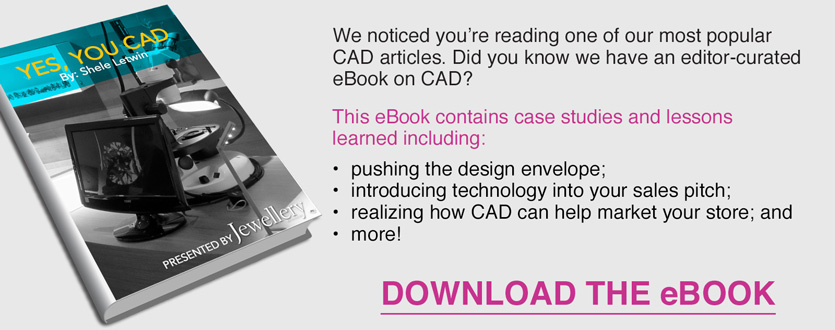To CAD or not to CAD?: Deciding when CAD is the right tool for a design
by jacquie_dealmeida | May 1, 2016 9:00 am
By Shele Lewin
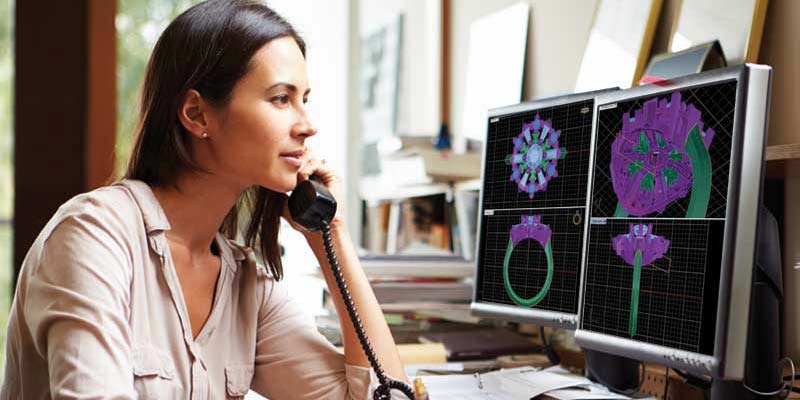 So I traded in my mukluks for a pair of flip flops and moved to California from Toronto. I have to say it was a bit surreal to listen to Christmas songs while the air conditioner hummed in the background. I do miss my native land, but the offer to move to a place with an abundance of sunshine and year-round temperatures in the mid-20s was too tempting.
So I traded in my mukluks for a pair of flip flops and moved to California from Toronto. I have to say it was a bit surreal to listen to Christmas songs while the air conditioner hummed in the background. I do miss my native land, but the offer to move to a place with an abundance of sunshine and year-round temperatures in the mid-20s was too tempting.
Before the move, my office was at 21 Dundas Square in Toronto, one of the city’s jewellery buildings. Yes, the elevators didn’t always work and the temperature inside was often too hot in the summer and a bit cold in the winter, but I loved the place. As a kid, I often mailed packages there from my parents’ store in Calgary. To me, it was the heart of Canada’s jewellery industry. And when I moved my business there in 2000, I felt I had become part of that special place.
When you work in a jewellery building, you tend to be surrounded by all manner of experts. Before starting to build a CAD model on a particularly challenging job, I often consulted with a variety of casters, setters, and jewellers on the different floors. Each one had their specialty and they bestowed on me a wealth of information. I am extremely grateful they were so willing to impart their knowledge, some of which I’m sharing with you in this column.
Although my business centred on distributing CAD/CAM products, I understood the importance of discerning when these were appropriate tools with which to design a piece of jewellery and when they weren’t. Let’s look at the most frequent occurrences of when CAD may not be the best design tool.
Important coloured stones
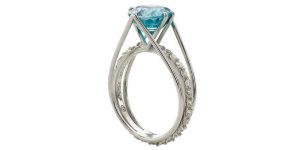
Creating a setting for a major coloured stone is one instance when hand-making a piece may be the better option for all or part of a job. While diamonds are cut to enhance their brilliance, coloured stones are cut for depth of colour, which means you could be working with a thicker, uneven girdle or a deep pavilion. For low-end to mid-price coloured gems, your setter can usually work with a setting made using CAD; however, when the gemstone is on the pricey side, there is nothing better than a hand-built head with the wire drawn down. Since the piece isn’t cast, the wire needs just a light polish, which spares the stone the possibility of damage. When executed correctly, the metal almost sparkles. In addition, settings built this way are stronger because the wire has been cold-hardened.
So when is it a good idea to have machines do some of the heavy lifting? Werner Swoboda of Platinum Unlimited in Toronto says he usually asks his CAD operator to design the shank in 3D, create the wax mould using a printer or milling machine, and build hand-drawn wires for the head. The client can get the best of both worlds—
a perfectly symmetrical shank with a super clean, very fine setting. You can’t help but take a little bit more time admiring pieces fashioned this way.
Matching bridal sets
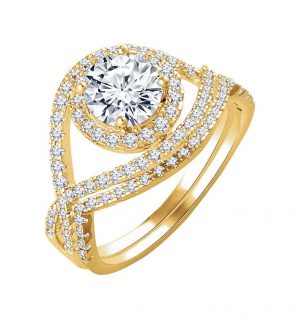
Fitted bridal sets tend to be the stuff of a CAD operator’s nightmares. A good CAD model is designed in interlocking parts, which allows the pieces to be polished separately and then assembled like a jigsaw puzzle. Interlocking parts keep the models straight when soldering. Even when dealing with a ring in a classic style, the end result may not be perfect when the mould for the original wax model was carved by hand. If you need a custom-made fitted band, CAD operators usually suggest getting the mould hand-carved. (Even though it can be done in CAD, setting up images and measuring the model are time-consuming.) People often opt not to pay for the extra time it would take to create the band in CAD when you consider a wax carver can simply heat up the engagement ring and press it against a piece of wax to get a perfect fit.
Organic-shape gemstones
My sister, Sharlane Letwin, was given an unmounted cameo as a gift from a very good friend. When she finally decided to have it set, she asked me to design a piece in CAD. The edges were thick in some areas and thin in others, so I had to decline. Instead, Sharlane went to a wax carver, who made a very simple bezel and charged her a reasonable price.
It’s all in the detail
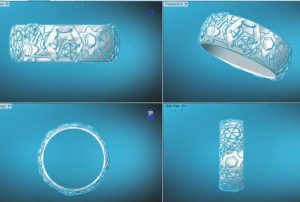 Dana Grund of Grund Designs in Halifax recently asked me to create a CAD design for a men’s wedding band featuring snowflake details, which we then printed and cast in platinum. While the printer did capture some of the snowflakes’ fine detail, Dana went over each one with a graver. Just like Mother Nature, no two snowflakes were the same. I was so impressed with the finished picture he sent me, I asked if I could use it in this article. Dana came back with these interesting points:
Dana Grund of Grund Designs in Halifax recently asked me to create a CAD design for a men’s wedding band featuring snowflake details, which we then printed and cast in platinum. While the printer did capture some of the snowflakes’ fine detail, Dana went over each one with a graver. Just like Mother Nature, no two snowflakes were the same. I was so impressed with the finished picture he sent me, I asked if I could use it in this article. Dana came back with these interesting points:
“The use of CAD as a means to a semi-finished blank is pretty key for me. In the case of the snowflake band, just getting the main shapes symmetrical and at different elevations would have been a nightmare. If I tried to render all the facets I cut in with the graver, it would have been too time-consuming and the piece would have lacked some of its soul.”
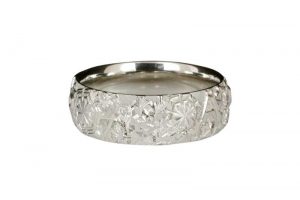
When speaking with jewellers at trade shows, I often find many of them are under the same impression that purchasing one software program (CAD) and one output machine (CAM) is all that’s needed. But take a look at your tool box at home. I’m sure it’s full of different kinds of tools, such as pliers or a wrench. Each one is appropriate for a specific task, although I have to admit
I have used the handle of a screwdriver as a hammer when I am too lazy to get one. As Travis Serio, a programmer for Gemvision, likes to say, “When we develop a new tool for our software, we often find everyone is quick to use it for everything when the best tool for the job could be one you already have.”
So, what interesting challenges have your customers brought you? Each goldsmith has their strengths and weaknesses, just like a piece of equipment. I love CAD—it has changed my life in ways I could not have imagined 20 years ago. It is exciting for me to see the latest tools and how they can help save time and money. Yet, I also recognize that CAD is not always the most appropriate tool for every job. While the goal may be to get a piece out to a customer as quick as possible, there is something to be said for doing things the old-fashioned way when it’s the best course of action.
I welcome your comments on this column or any of the others I’ve written over the last few years. If there is some particular aspect of CAD you’d like me to address in a future article, drop me a note. I’d love to hear from you.
Shele Letwin is a graduate of the jewellery arts program at Toronto’s George Brown College, an award-winning designer, and a CAD/CAM instructor. She has been a regular guest speaker at trade shows in both Canada and the United States. Letwin can be reached via e-mail at slletwin@gmail.com.
Source URL: https://www.jewellerybusiness.com/features/to-cad-or-not-to-cad-deciding-when-cad-is-the-right-tool-for-a-design/
